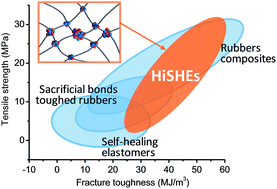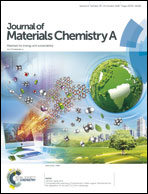Super tough and strong self-healing elastomers based on polyampholytes†
Abstract
A huge challenge for developing self-healing elastomers is achieving a compromise between mechanical properties and healing efficiency. Here, we report a class of high performance self-healing elastomers (HiSHEs) with an exceptional combination of strength (up to 30 MPa), toughness (up to 32 kJ m−2) and healing efficiency (>80%). The HiSHEs are made of polyampholytes synthesized through kinetically controlled copolymerization of an acrylate monomer with long alkyl side groups and a pair of oppositely charged monomers that forms precipitates slowly. The acrylate monomer enables the formation of polymer chains of high mobility, while the oppositely charged monomers form gradient interactions by segregating into ionic aggregates with a wide range of sizes and stiffnesses. The weak interactions sacrifice progressively to dissipate energy, thereby enhancing the toughness, and the strong interactions impart the elastomers with high strength and elasticity. Moreover, the reversible gradient interactions also enable self-healing and multi-shape memory functions. By harnessing these functions, we design a mendable strain sensor with remarkably improved sensitivity.



 Please wait while we load your content...
Please wait while we load your content...